Ramon Cedeño
Director, Bioregional Education Program
Planet Drum Foundation
Bioregionalismo Report #1, 2011 – English
(Click here for Spanish/Español)
Photos below.
Another year of Bioregionalismo class commences. This year we are working with three educational institutions: the girls school Juan Pio Montúfar, Genesis high school, and the national high school Fanny de Baird, with whom we worked last year. There are three new class assistants, two students from last year: Noemi and Luis, and an assistant teacher from Genesis. We also have a new professor, David Mera, a natural sciences teacher from Fanny. And of course there’s Margarita Avila Napa [aka Plager-Unger] a professor from last year, and me.
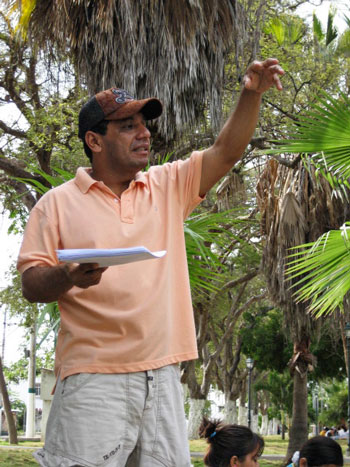
I am teaching the group of girls from the Montúfar School. We have received complete support from the faculty to proceed with the after school environmental education classes. It’s a new year for new experiences and for me that means leading a group of 11 year old girls. They are very little, but have lots of energy.
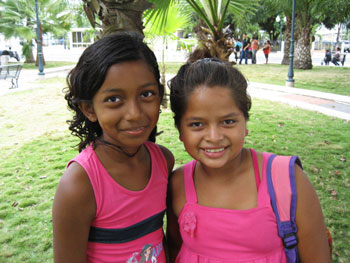
The first week was about introductions. I explained to them the different topics of the education program and that our goal is to teach the students to have better lifestyles and to learn how to live in harmony with nature. There will be a lot for them to learn, but they are motivated to help the environment. With the help of my assistant, Noemi, we split the class into work groups. During the fieldtrip on Friday at the Cross Lookout, we were able to observe in person the characteristics of our bioregion. I can tell that the girls in my group are already bonding into a special group of bioregionalistas.

booklet. Photo by Clay Plager-Unger
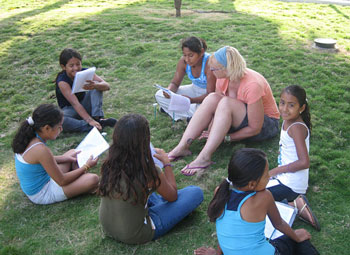


Chila.
m
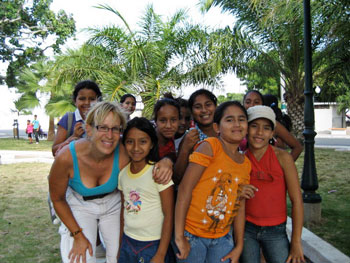
The next week, we conversed about the different ecological projects which have been implemented in our city, including our education program, led by Planet Drum, which also has a project for revegetating hillsides.

of students from the Montufar school. Photo by Clay Plager-Unger.
I asked them a question: if they knew Peter Berg? They said no. So I gave Orlando, who is helping with all three groups, a mission: to borrow Peter’s book from the Planet Drum house so that we could at least present a picture of him to the students. And that’s why Orlando borrowed the book.
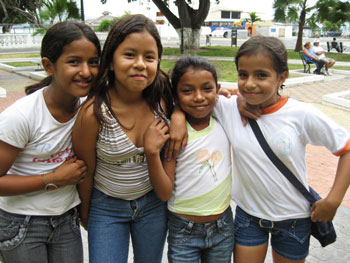

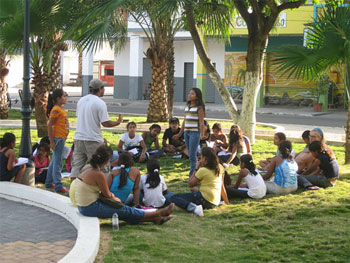
On Friday we went to the Lookout in Bellavista with all of the students from the three groups at once. Orlando, a resident of that neighborhood explained about the different projects that have happened there. He was a big help, as always. I talked about the trees that Planet Drum has been planting there for the past six years. Then Nicole, Orlando’s daughter, who happens to be a student in my group, showed the other students the organic garden that is being built there.
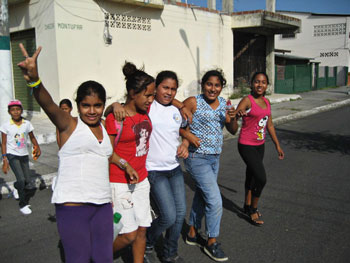

Bellavista. Photo by Michelle Jensen.
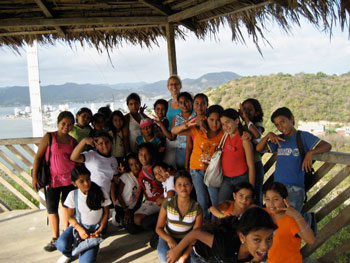

Our destination was ‘The Forest Amidst the Ruins,’ on the way we passed by the Planet Drum house and picked up more trees to transplant and tools. We were accompanied by three Peace Corps volunteers and all of the Planet Drum volunteers: Jack, Chris, Dennis, Guillem, and Michelle. It was very beautiful to see how free the children felt running around on the trails in the park. Thanks to the Planet Drum volunteers for helping to clean up the trails that week! The children ran, yelled and jumped up and down. I told them the history of that place and what happened during the El Niño Phenomenon. Then we planted all of the trees we had brought in the ground.
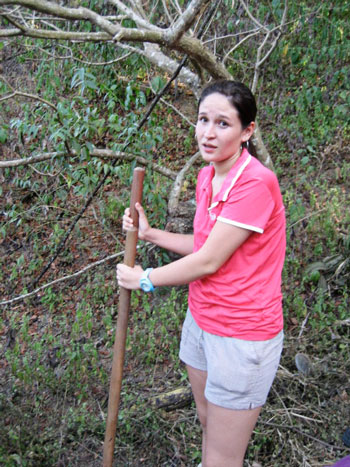
planting trees. Photo by Michelle Jensen.

en Medio de las Ruinas’ (The Forest amidst the Ruins) park during a fieldtrip. Photo by Michelle Jensen.

Photo by Michelle Jensen.
During the fourth week, the students had to show what they had learned so far by taking a bioregionlism exam. The results were really good and this gave me a motivational boost because these children are part of a new generation. That day we had invited a special guest, Felipe Sanchez, a survivor from the El Niño Phenomenon. All three groups sat in a large circle in the middle of the park to listen to him. Felipe gave a presentation of his experience during the phenomenon. He told us that rivers formed where there were none and how they rescued people who used to live on the hillside that is now ‘The Forest Amidst the Ruins.’ He explained that all of the houses that were there were completely destroyed. It was a very animated speech and a great experience for the children.
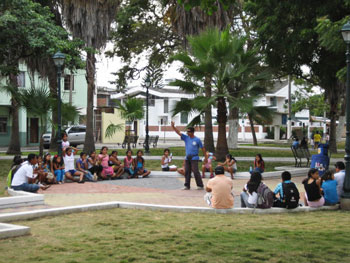
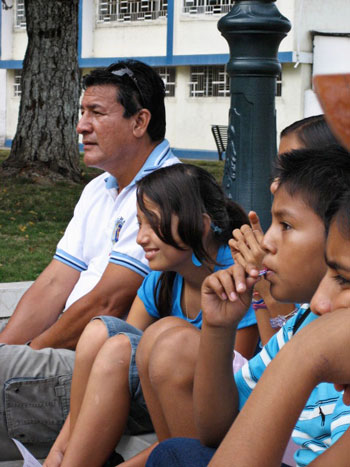

On Friday we took a hike from Leonidas Plaza to Bellaca beach. As we walked over the long hill, the students took the form of a great column. Since all of the students wore their dark green Bioregionista tee-shirts, it was very cool to see. Noemi took the lead at the head of the column with the girls from Montúfar School. David, Orlando, Margarita and I took up the rear with the girls from the Fanny group who were walking more slowly. Since the hike goes past one of the garbage dumps, all of students were shocked to see so much trash. But in the end they had a good time and got to swim in the ocean.
Ramón Cedeño
Director Programa de Educación Bioregional
Fundación Planet Drum
Bahía de Caráquez, Ecuador
Translated by Clay
Ramon Cedeño
Director Programa Bioregionalismo
Fundación Planet Drum
Bahía de Caráquez, Ecuador
Informe #1 – Spanish/Español
Empezamos un nuevo año de educación bioregional, este año con la colaboración de tres instituciones educativas: la escuela de niñas Juan Pio Montúfar, colegio Génesis y el colegio Nacional Fanny de Baird con quien se firmo un convenio el año pasado un convenio para realizar el programa de educación bioregional, además de tener nuevos asistentes Noemí, Luis y profesor David Mera que trabaja con el grupo del Fanny de Baird ya que el es el profesor del mismo colegio.
Este año estoy trabajando con las niñas de la escuela Montúfar, donde hay un apoyo total de parte de las autoridades de la institución.
Es un nuevo año para adquirir una nueva experiencia, trabajar con un grupo de niñas de 11 años. Son muy pequeñas y con mucha energía. La primera semana hablamos sobre en que consistía este proyecto y lo que queremos que ellas aprendan para llevar un mejor estilo de vida además de aprender a vivir en armonía con la naturaleza. Hay cosas que desconocen pero como ellas decían están aquí para cuidar el medio ambiente. Hemos formado grupo de trabajos con la participación activa de Noemí, quien es mi asistente, pero que por su estatura se confunde con las niñas. Durante el recorrido el día viernes, observamos las características de la bioregión desde el mirador la cruz. Es bueno saber que ellas a pesar de que no tenemos mucho tiempo han logrado hacer un gran grupo.
Departimos sobre los diferentes proyectos que se han implementado en nuestra ciudad y que uno de ellos es el programa de educación ambiental, además de los programas de reforestación que hace la misma fundación Planet Drum y la participación activa que esta tiene en la ciudad. Les hice una pregunta: si conocían a Peter Berg, y me dijeron que no. Y como tenemos un ayudante que siempre está con nosotros, nuestro amigo Orlando. Le dejamos una misión de que como no lo conocen si lo presentaríamos en foto. Es por eso que el prestó el libro, y lo conocieron por foto.
El día viernes, fuimos al mirador de Bellavista con un gran grupo de estudiantes. Nuestro amigo Orlando habló sobre los proyectos que se han realizado en el barrio. Nos ayudó como siempre. Hablé un poco sobre los árboles que fueron plantados ahí por Heather y los voluntarios de Planet Drum hace 6 años. Después, Nicole llevó al grupo a observar el huerto orgánico que se están construyendo en unas terrazas en la misma comunidad.
En la tercera semana, nos toco analizar los diez pasos para proteger una bioregión. Todas las chicas quieren participar y por la gran cantidad de niñas y dos chicos en total hacen 23 bioregionalistas solo en mi grupo. Juan Ramón es uno de los chicos mas activos del grupo y aunque él es de otra institución educativa siempre está contestando rápidamente a las preguntas. Teníamos un cupo limitado de estudiantes, pero todas las semanas a mi clase llegan nuevas personas que quiere ingresar y los dejo participar por que esas personas también tienen ganas de formar parte del grupo. Antes de salir les dije al grupo que dirijo que deben llevar agua por que plantaremos árboles el día del recorrido.
El viernes nos reunimos en el parque como siempre. Vi llegar a cada una de los estudiantes con una poma de agua para regar los árboles. Unas de ellas traían arbolitos de mango de sus casas para sembrarlos. Pasando por la casa de Planet Drum, recogimos más árboles y herramientas. Después nos dirigimos al Bosque en Medio de las Ruinas. Nos acompañaron tres voluntarios del Cuerpo de Paz y todos los voluntarios de Planet Drum: Jack, Chris, Dennis, Guillem, y Michelle. Fue muy hermoso ver como los chicos se sentían libres en los senderos que fueron habilitados durante la semana de trabajo de voluntarios de la fundación. Los estudiantes corrían, gritaban, y saltaban. Yo les relaté la historia del lugar y que paso con el desastre durante en el fenómeno del Niño. Luego plantamos todos los arbolitos que habíamos llevado.
En la cuarta semana donde los estudiantes tenían que decir todo lo que aprendieron durante las primeras semanas. El resultado fue muy bueno y esto me motiva más por que estos jóvenes son parte de una nueva generación. Este día fue invitado el señor Felipe Sánchez, una de las personas que sobrevivió el fenómeno del Niño. Nos sentamos en un círculo grande con la escuela Montúfar y Fanny de Baird. Felipe nos relató su experiencia de como se formaron ríos donde no habían y como rescataron personas que vivían donde ahora es en el Bosque en Medio de la Ruinas. Nos contó que todas las casas que existieron en ese lugar desaparecieron. Fue una buena experiencia para los estudiantes.
El día viernes todos los grupos nos dirigimos a Playa Gringa. Éramos una gran columna de estudiantes con un solo color de camisetas. Noemí encabezo la columna con las niñas de la escuela Montúfar. El profesor David, Orlando, Margarita y yo estábamos atrás con unas de las niñas del colegio Fanny que iban más despacio. Cuando llegamos, se me acercaron los jóvenes y me dijeron sobre la gran cantidad de basura que vieron en el recorrido.

Can you be more specific about the content of your article? After reading it, I still have some doubts. Hope you can help me.
Can you be more specific about the content of your article? After reading it, I still have some doubts. Hope you can help me.